Comprehensive Analysis of Risk Management Strategies & Tools
VerifiedAdded on 2023/01/17
|20
|5201
|69
Report
AI Summary
This report provides a comprehensive analysis of risk management strategies and tools applicable to business organizations. It begins by defining different types of risks, such as strategic, operational, and external risks, and outlines the key steps in the risk management process, emphasizing the importance of continual mitigation and risk avoidance. The report identifies various information sources for understanding organizational objectives and applies PESTLE analysis to Marks and Spencer, highlighting the impact of political, economic, social, technological, environmental, and legal factors. It discusses methods for determining internal and external stakeholders and defines the purpose of risk criteria. Furthermore, the report details tools used in risk identification, including brainstorming, Delphi technique, root cause analysis, analogous project comparisons, and affinity diagrams. It distinguishes between qualitative and quantitative risk analysis and explains the use of likelihood and consequences tables. Finally, it outlines five options for risk treatment, including risk avoidance, reduction, sharing, and retention, providing a thorough overview of risk management principles and practices.
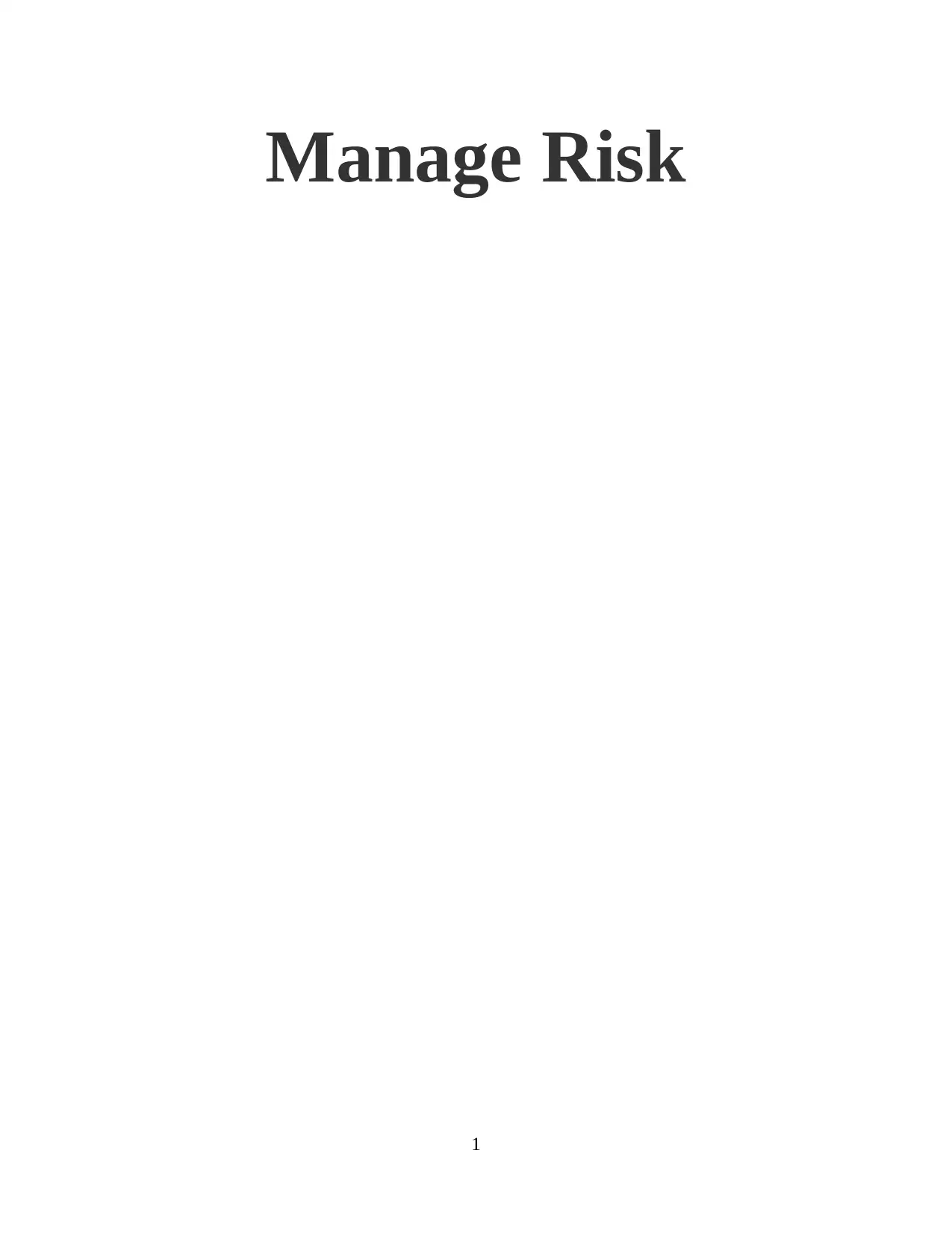
Manage Risk
1
1
Paraphrase This Document
Need a fresh take? Get an instant paraphrase of this document with our AI Paraphraser
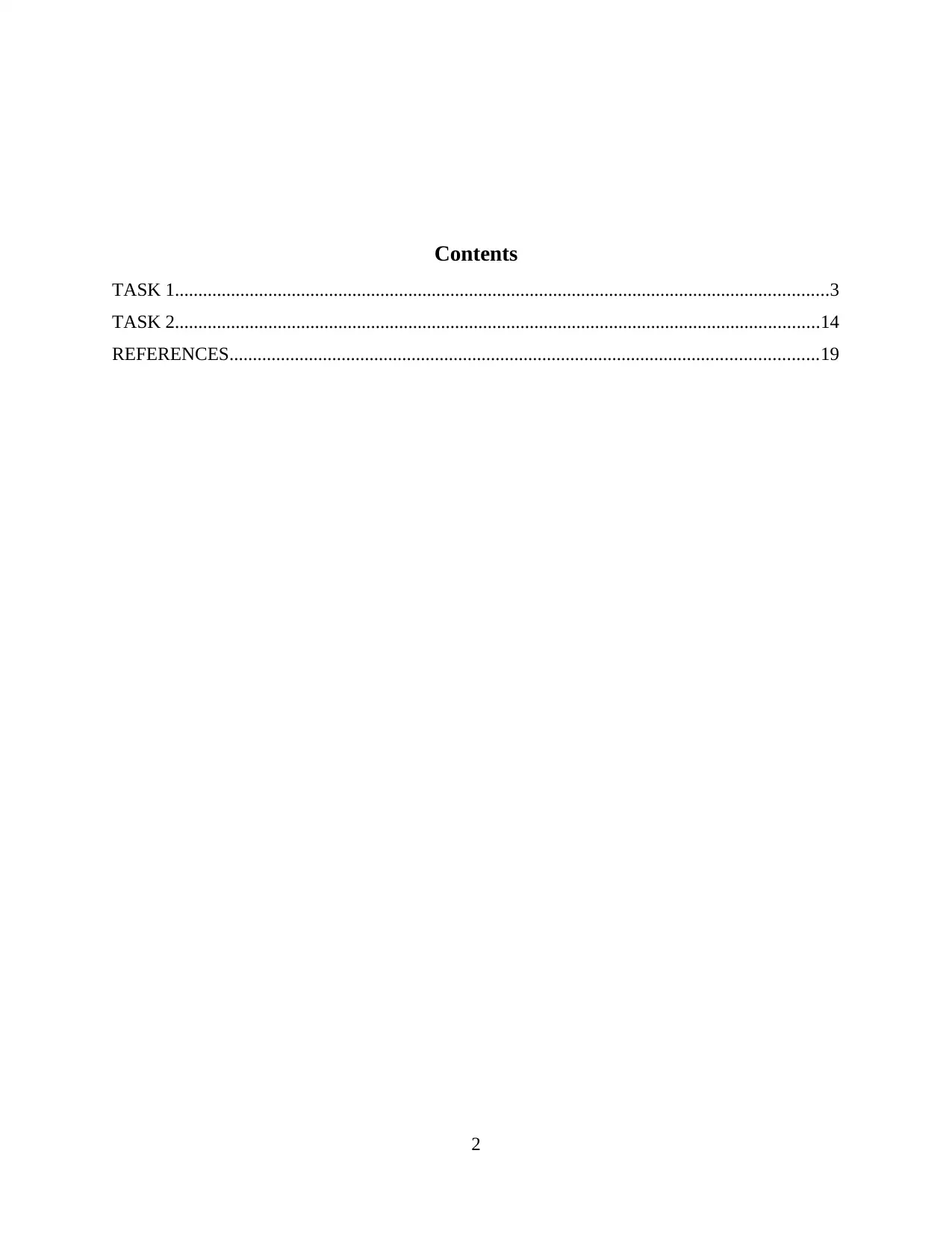
Contents
TASK 1............................................................................................................................................3
TASK 2..........................................................................................................................................14
REFERENCES..............................................................................................................................19
2
TASK 1............................................................................................................................................3
TASK 2..........................................................................................................................................14
REFERENCES..............................................................................................................................19
2
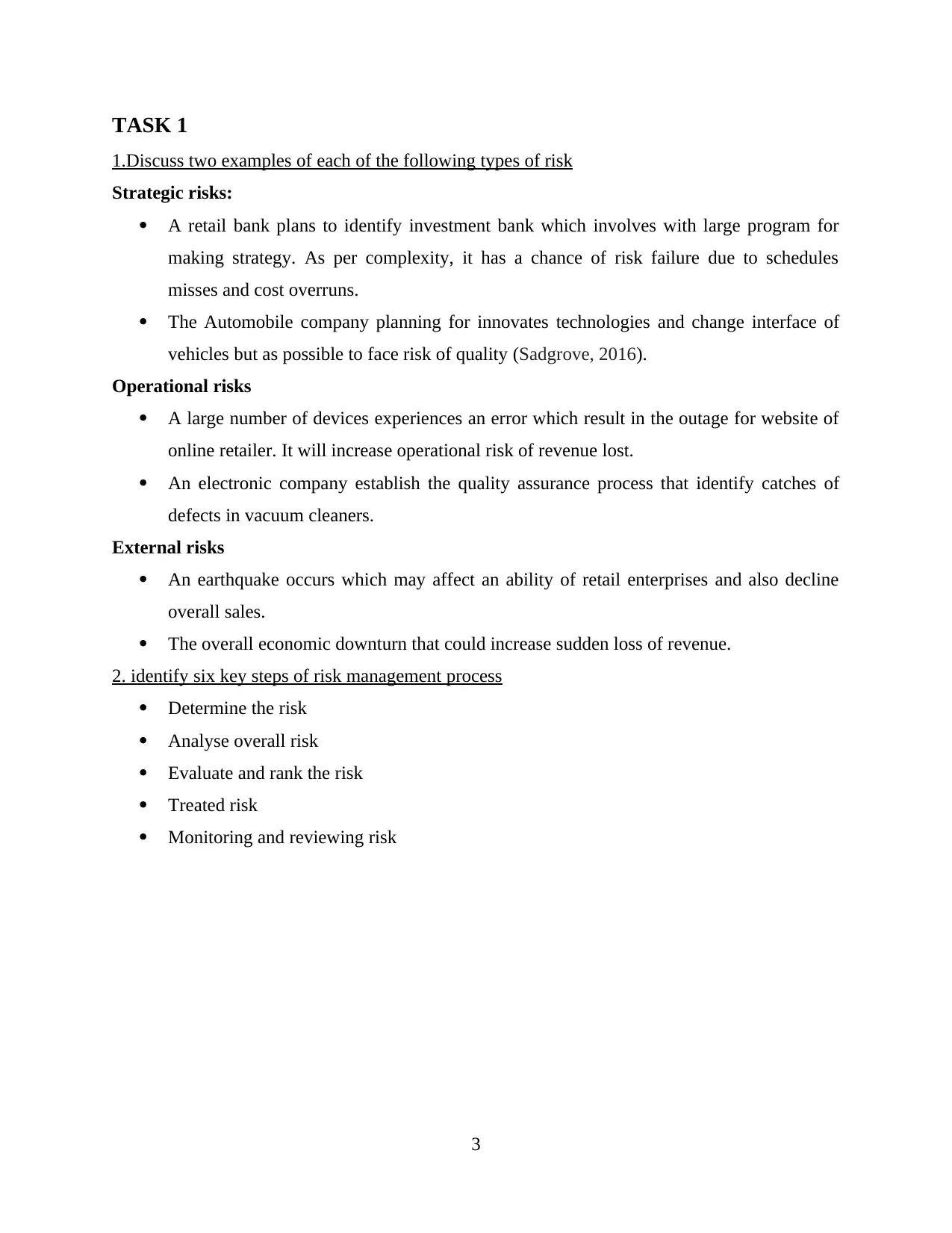
TASK 1
1.Discuss two examples of each of the following types of risk
Strategic risks:
A retail bank plans to identify investment bank which involves with large program for
making strategy. As per complexity, it has a chance of risk failure due to schedules
misses and cost overruns.
The Automobile company planning for innovates technologies and change interface of
vehicles but as possible to face risk of quality (Sadgrove, 2016).
Operational risks
A large number of devices experiences an error which result in the outage for website of
online retailer. It will increase operational risk of revenue lost.
An electronic company establish the quality assurance process that identify catches of
defects in vacuum cleaners.
External risks
An earthquake occurs which may affect an ability of retail enterprises and also decline
overall sales.
The overall economic downturn that could increase sudden loss of revenue.
2. identify six key steps of risk management process
Determine the risk
Analyse overall risk
Evaluate and rank the risk
Treated risk
Monitoring and reviewing risk
3
1.Discuss two examples of each of the following types of risk
Strategic risks:
A retail bank plans to identify investment bank which involves with large program for
making strategy. As per complexity, it has a chance of risk failure due to schedules
misses and cost overruns.
The Automobile company planning for innovates technologies and change interface of
vehicles but as possible to face risk of quality (Sadgrove, 2016).
Operational risks
A large number of devices experiences an error which result in the outage for website of
online retailer. It will increase operational risk of revenue lost.
An electronic company establish the quality assurance process that identify catches of
defects in vacuum cleaners.
External risks
An earthquake occurs which may affect an ability of retail enterprises and also decline
overall sales.
The overall economic downturn that could increase sudden loss of revenue.
2. identify six key steps of risk management process
Determine the risk
Analyse overall risk
Evaluate and rank the risk
Treated risk
Monitoring and reviewing risk
3
⊘ This is a preview!⊘
Do you want full access?
Subscribe today to unlock all pages.

Trusted by 1+ million students worldwide
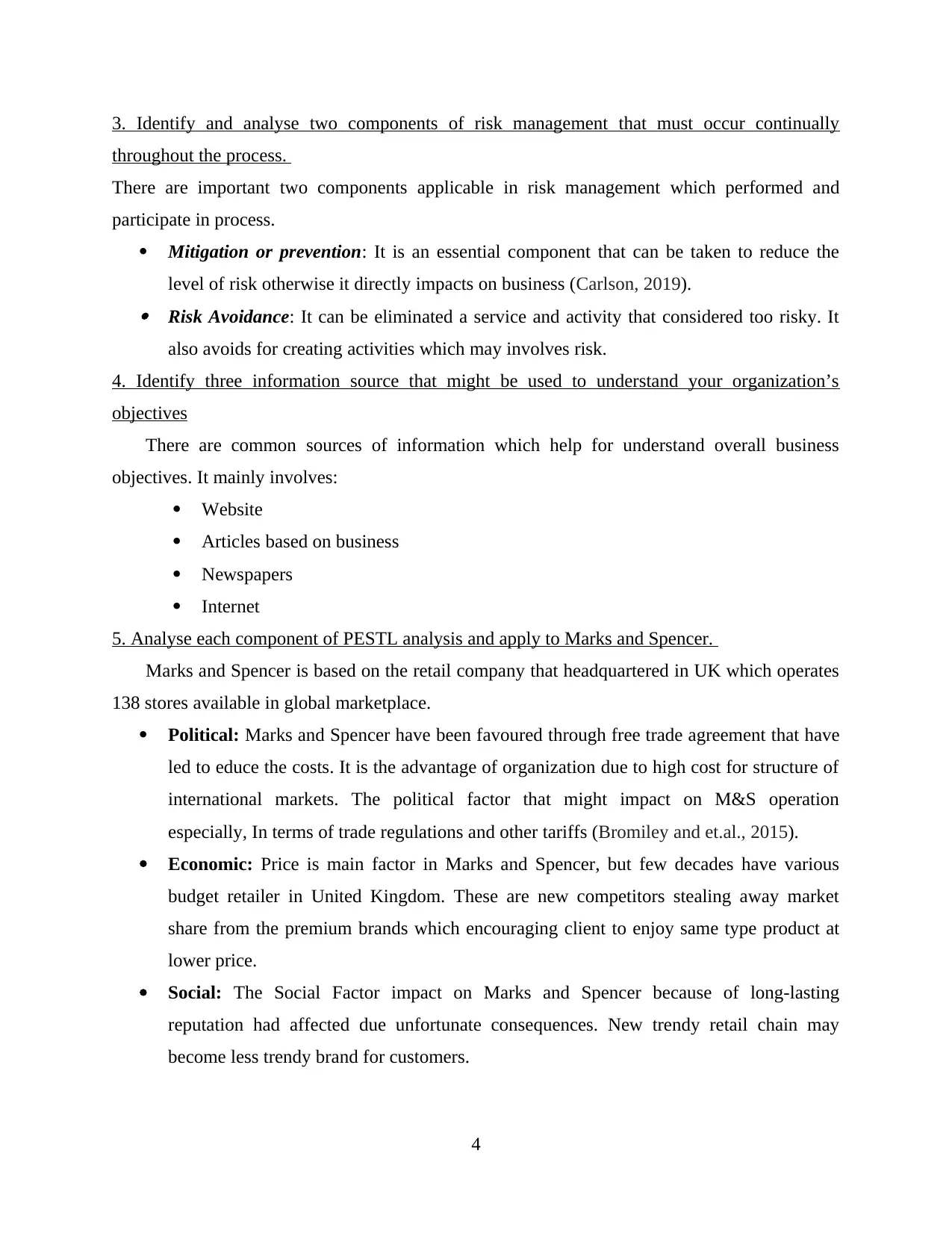
3. Identify and analyse two components of risk management that must occur continually
throughout the process.
There are important two components applicable in risk management which performed and
participate in process.
Mitigation or prevention: It is an essential component that can be taken to reduce the
level of risk otherwise it directly impacts on business (Carlson, 2019). Risk Avoidance: It can be eliminated a service and activity that considered too risky. It
also avoids for creating activities which may involves risk.
4. Identify three information source that might be used to understand your organization’s
objectives
There are common sources of information which help for understand overall business
objectives. It mainly involves:
Website
Articles based on business
Newspapers
Internet
5. Analyse each component of PESTL analysis and apply to Marks and Spencer.
Marks and Spencer is based on the retail company that headquartered in UK which operates
138 stores available in global marketplace.
Political: Marks and Spencer have been favoured through free trade agreement that have
led to educe the costs. It is the advantage of organization due to high cost for structure of
international markets. The political factor that might impact on M&S operation
especially, In terms of trade regulations and other tariffs (Bromiley and et.al., 2015).
Economic: Price is main factor in Marks and Spencer, but few decades have various
budget retailer in United Kingdom. These are new competitors stealing away market
share from the premium brands which encouraging client to enjoy same type product at
lower price.
Social: The Social Factor impact on Marks and Spencer because of long-lasting
reputation had affected due unfortunate consequences. New trendy retail chain may
become less trendy brand for customers.
4
throughout the process.
There are important two components applicable in risk management which performed and
participate in process.
Mitigation or prevention: It is an essential component that can be taken to reduce the
level of risk otherwise it directly impacts on business (Carlson, 2019). Risk Avoidance: It can be eliminated a service and activity that considered too risky. It
also avoids for creating activities which may involves risk.
4. Identify three information source that might be used to understand your organization’s
objectives
There are common sources of information which help for understand overall business
objectives. It mainly involves:
Website
Articles based on business
Newspapers
Internet
5. Analyse each component of PESTL analysis and apply to Marks and Spencer.
Marks and Spencer is based on the retail company that headquartered in UK which operates
138 stores available in global marketplace.
Political: Marks and Spencer have been favoured through free trade agreement that have
led to educe the costs. It is the advantage of organization due to high cost for structure of
international markets. The political factor that might impact on M&S operation
especially, In terms of trade regulations and other tariffs (Bromiley and et.al., 2015).
Economic: Price is main factor in Marks and Spencer, but few decades have various
budget retailer in United Kingdom. These are new competitors stealing away market
share from the premium brands which encouraging client to enjoy same type product at
lower price.
Social: The Social Factor impact on Marks and Spencer because of long-lasting
reputation had affected due unfortunate consequences. New trendy retail chain may
become less trendy brand for customers.
4
Paraphrase This Document
Need a fresh take? Get an instant paraphrase of this document with our AI Paraphraser
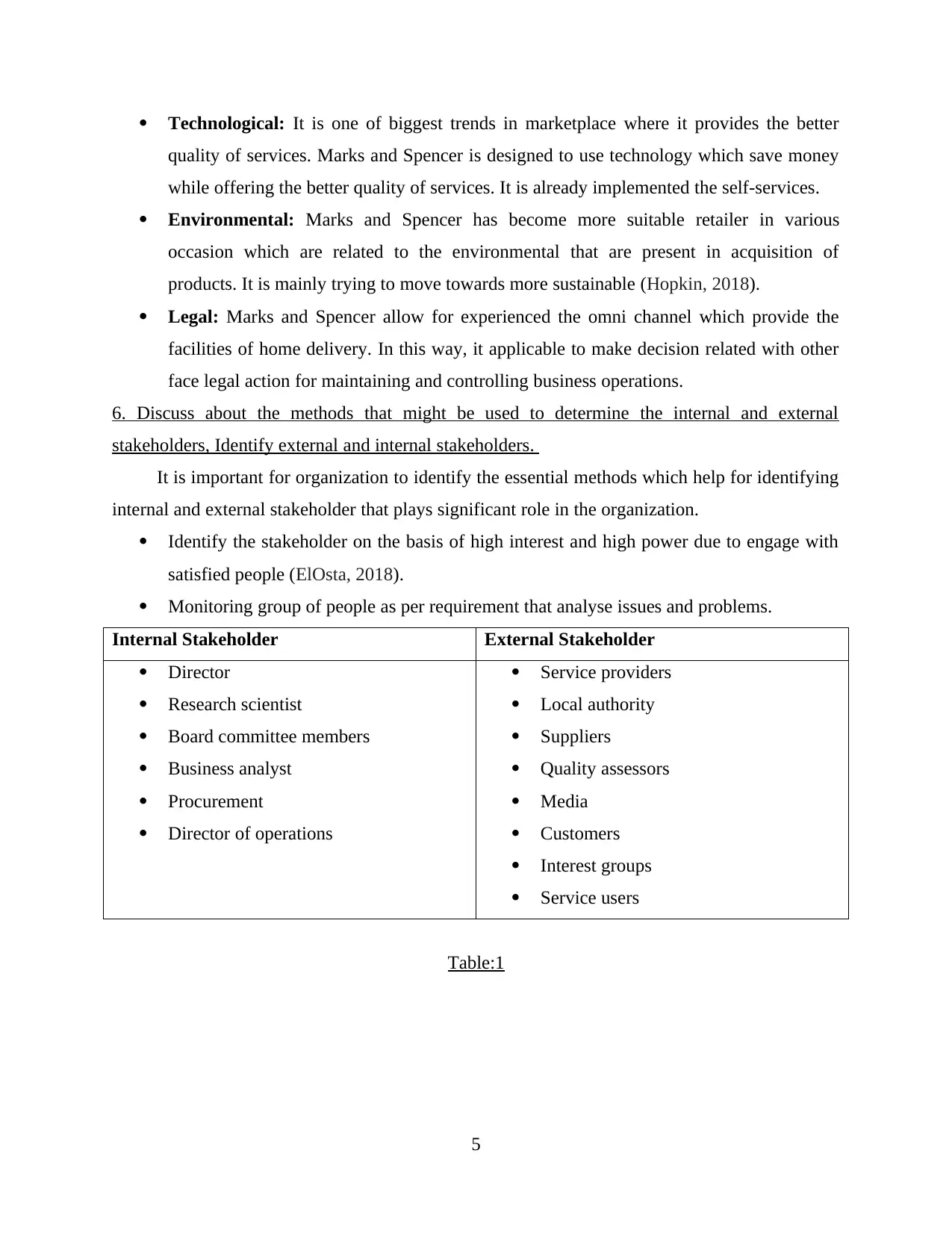
Technological: It is one of biggest trends in marketplace where it provides the better
quality of services. Marks and Spencer is designed to use technology which save money
while offering the better quality of services. It is already implemented the self-services.
Environmental: Marks and Spencer has become more suitable retailer in various
occasion which are related to the environmental that are present in acquisition of
products. It is mainly trying to move towards more sustainable (Hopkin, 2018).
Legal: Marks and Spencer allow for experienced the omni channel which provide the
facilities of home delivery. In this way, it applicable to make decision related with other
face legal action for maintaining and controlling business operations.
6. Discuss about the methods that might be used to determine the internal and external
stakeholders, Identify external and internal stakeholders.
It is important for organization to identify the essential methods which help for identifying
internal and external stakeholder that plays significant role in the organization.
Identify the stakeholder on the basis of high interest and high power due to engage with
satisfied people (ElOsta, 2018).
Monitoring group of people as per requirement that analyse issues and problems.
Internal Stakeholder External Stakeholder
Director
Research scientist
Board committee members
Business analyst
Procurement
Director of operations
Service providers
Local authority
Suppliers
Quality assessors
Media
Customers
Interest groups
Service users
Table:1
5
quality of services. Marks and Spencer is designed to use technology which save money
while offering the better quality of services. It is already implemented the self-services.
Environmental: Marks and Spencer has become more suitable retailer in various
occasion which are related to the environmental that are present in acquisition of
products. It is mainly trying to move towards more sustainable (Hopkin, 2018).
Legal: Marks and Spencer allow for experienced the omni channel which provide the
facilities of home delivery. In this way, it applicable to make decision related with other
face legal action for maintaining and controlling business operations.
6. Discuss about the methods that might be used to determine the internal and external
stakeholders, Identify external and internal stakeholders.
It is important for organization to identify the essential methods which help for identifying
internal and external stakeholder that plays significant role in the organization.
Identify the stakeholder on the basis of high interest and high power due to engage with
satisfied people (ElOsta, 2018).
Monitoring group of people as per requirement that analyse issues and problems.
Internal Stakeholder External Stakeholder
Director
Research scientist
Board committee members
Business analyst
Procurement
Director of operations
Service providers
Local authority
Suppliers
Quality assessors
Media
Customers
Interest groups
Service users
Table:1
5
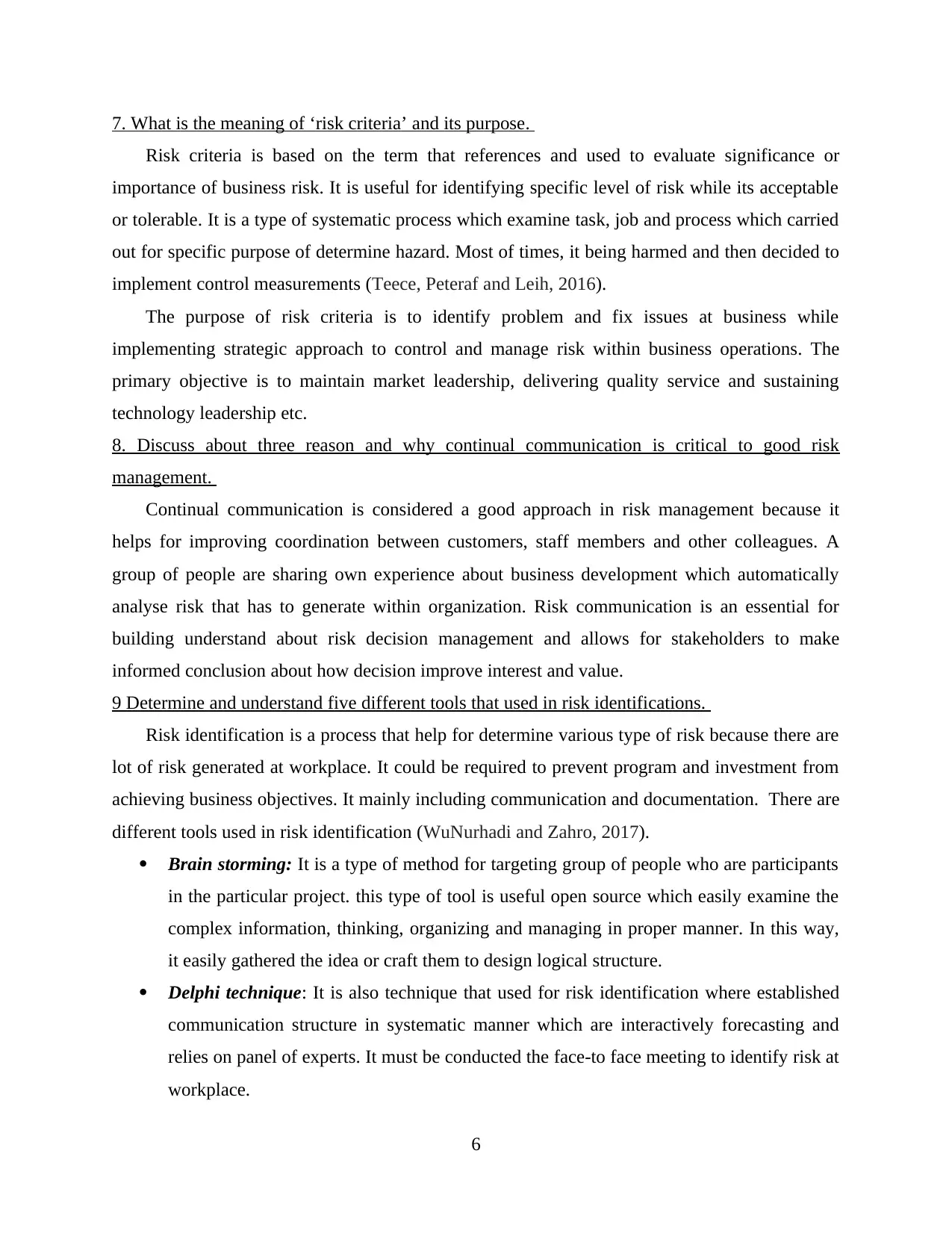
7. What is the meaning of ‘risk criteria’ and its purpose.
Risk criteria is based on the term that references and used to evaluate significance or
importance of business risk. It is useful for identifying specific level of risk while its acceptable
or tolerable. It is a type of systematic process which examine task, job and process which carried
out for specific purpose of determine hazard. Most of times, it being harmed and then decided to
implement control measurements (Teece, Peteraf and Leih, 2016).
The purpose of risk criteria is to identify problem and fix issues at business while
implementing strategic approach to control and manage risk within business operations. The
primary objective is to maintain market leadership, delivering quality service and sustaining
technology leadership etc.
8. Discuss about three reason and why continual communication is critical to good risk
management.
Continual communication is considered a good approach in risk management because it
helps for improving coordination between customers, staff members and other colleagues. A
group of people are sharing own experience about business development which automatically
analyse risk that has to generate within organization. Risk communication is an essential for
building understand about risk decision management and allows for stakeholders to make
informed conclusion about how decision improve interest and value.
9 Determine and understand five different tools that used in risk identifications.
Risk identification is a process that help for determine various type of risk because there are
lot of risk generated at workplace. It could be required to prevent program and investment from
achieving business objectives. It mainly including communication and documentation. There are
different tools used in risk identification (WuNurhadi and Zahro, 2017).
Brain storming: It is a type of method for targeting group of people who are participants
in the particular project. this type of tool is useful open source which easily examine the
complex information, thinking, organizing and managing in proper manner. In this way,
it easily gathered the idea or craft them to design logical structure.
Delphi technique: It is also technique that used for risk identification where established
communication structure in systematic manner which are interactively forecasting and
relies on panel of experts. It must be conducted the face-to face meeting to identify risk at
workplace.
6
Risk criteria is based on the term that references and used to evaluate significance or
importance of business risk. It is useful for identifying specific level of risk while its acceptable
or tolerable. It is a type of systematic process which examine task, job and process which carried
out for specific purpose of determine hazard. Most of times, it being harmed and then decided to
implement control measurements (Teece, Peteraf and Leih, 2016).
The purpose of risk criteria is to identify problem and fix issues at business while
implementing strategic approach to control and manage risk within business operations. The
primary objective is to maintain market leadership, delivering quality service and sustaining
technology leadership etc.
8. Discuss about three reason and why continual communication is critical to good risk
management.
Continual communication is considered a good approach in risk management because it
helps for improving coordination between customers, staff members and other colleagues. A
group of people are sharing own experience about business development which automatically
analyse risk that has to generate within organization. Risk communication is an essential for
building understand about risk decision management and allows for stakeholders to make
informed conclusion about how decision improve interest and value.
9 Determine and understand five different tools that used in risk identifications.
Risk identification is a process that help for determine various type of risk because there are
lot of risk generated at workplace. It could be required to prevent program and investment from
achieving business objectives. It mainly including communication and documentation. There are
different tools used in risk identification (WuNurhadi and Zahro, 2017).
Brain storming: It is a type of method for targeting group of people who are participants
in the particular project. this type of tool is useful open source which easily examine the
complex information, thinking, organizing and managing in proper manner. In this way,
it easily gathered the idea or craft them to design logical structure.
Delphi technique: It is also technique that used for risk identification where established
communication structure in systematic manner which are interactively forecasting and
relies on panel of experts. It must be conducted the face-to face meeting to identify risk at
workplace.
6
⊘ This is a preview!⊘
Do you want full access?
Subscribe today to unlock all pages.

Trusted by 1+ million students worldwide
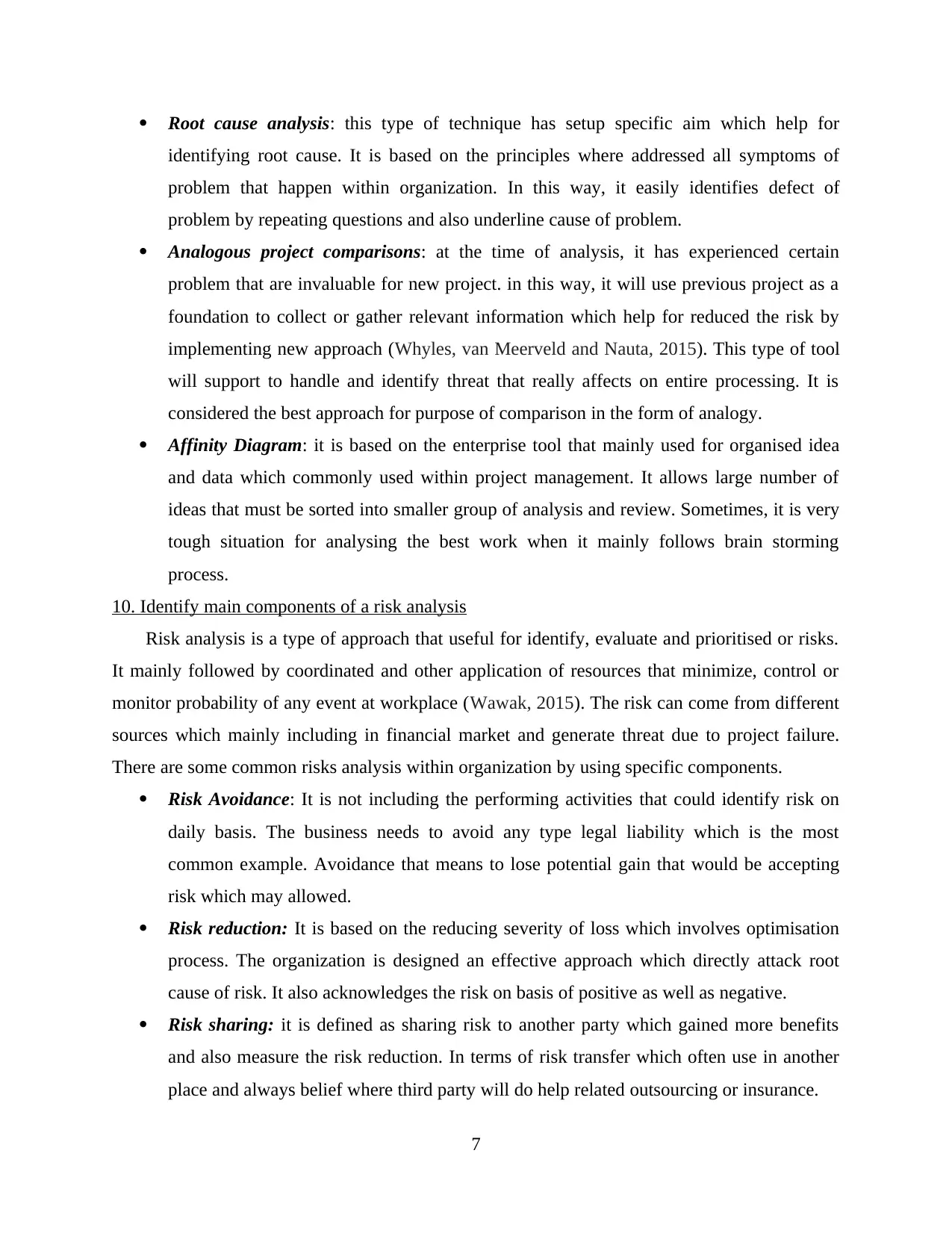
Root cause analysis: this type of technique has setup specific aim which help for
identifying root cause. It is based on the principles where addressed all symptoms of
problem that happen within organization. In this way, it easily identifies defect of
problem by repeating questions and also underline cause of problem.
Analogous project comparisons: at the time of analysis, it has experienced certain
problem that are invaluable for new project. in this way, it will use previous project as a
foundation to collect or gather relevant information which help for reduced the risk by
implementing new approach (Whyles, van Meerveld and Nauta, 2015). This type of tool
will support to handle and identify threat that really affects on entire processing. It is
considered the best approach for purpose of comparison in the form of analogy.
Affinity Diagram: it is based on the enterprise tool that mainly used for organised idea
and data which commonly used within project management. It allows large number of
ideas that must be sorted into smaller group of analysis and review. Sometimes, it is very
tough situation for analysing the best work when it mainly follows brain storming
process.
10. Identify main components of a risk analysis
Risk analysis is a type of approach that useful for identify, evaluate and prioritised or risks.
It mainly followed by coordinated and other application of resources that minimize, control or
monitor probability of any event at workplace (Wawak, 2015). The risk can come from different
sources which mainly including in financial market and generate threat due to project failure.
There are some common risks analysis within organization by using specific components.
Risk Avoidance: It is not including the performing activities that could identify risk on
daily basis. The business needs to avoid any type legal liability which is the most
common example. Avoidance that means to lose potential gain that would be accepting
risk which may allowed.
Risk reduction: It is based on the reducing severity of loss which involves optimisation
process. The organization is designed an effective approach which directly attack root
cause of risk. It also acknowledges the risk on basis of positive as well as negative.
Risk sharing: it is defined as sharing risk to another party which gained more benefits
and also measure the risk reduction. In terms of risk transfer which often use in another
place and always belief where third party will do help related outsourcing or insurance.
7
identifying root cause. It is based on the principles where addressed all symptoms of
problem that happen within organization. In this way, it easily identifies defect of
problem by repeating questions and also underline cause of problem.
Analogous project comparisons: at the time of analysis, it has experienced certain
problem that are invaluable for new project. in this way, it will use previous project as a
foundation to collect or gather relevant information which help for reduced the risk by
implementing new approach (Whyles, van Meerveld and Nauta, 2015). This type of tool
will support to handle and identify threat that really affects on entire processing. It is
considered the best approach for purpose of comparison in the form of analogy.
Affinity Diagram: it is based on the enterprise tool that mainly used for organised idea
and data which commonly used within project management. It allows large number of
ideas that must be sorted into smaller group of analysis and review. Sometimes, it is very
tough situation for analysing the best work when it mainly follows brain storming
process.
10. Identify main components of a risk analysis
Risk analysis is a type of approach that useful for identify, evaluate and prioritised or risks.
It mainly followed by coordinated and other application of resources that minimize, control or
monitor probability of any event at workplace (Wawak, 2015). The risk can come from different
sources which mainly including in financial market and generate threat due to project failure.
There are some common risks analysis within organization by using specific components.
Risk Avoidance: It is not including the performing activities that could identify risk on
daily basis. The business needs to avoid any type legal liability which is the most
common example. Avoidance that means to lose potential gain that would be accepting
risk which may allowed.
Risk reduction: It is based on the reducing severity of loss which involves optimisation
process. The organization is designed an effective approach which directly attack root
cause of risk. It also acknowledges the risk on basis of positive as well as negative.
Risk sharing: it is defined as sharing risk to another party which gained more benefits
and also measure the risk reduction. In terms of risk transfer which often use in another
place and always belief where third party will do help related outsourcing or insurance.
7
Paraphrase This Document
Need a fresh take? Get an instant paraphrase of this document with our AI Paraphraser
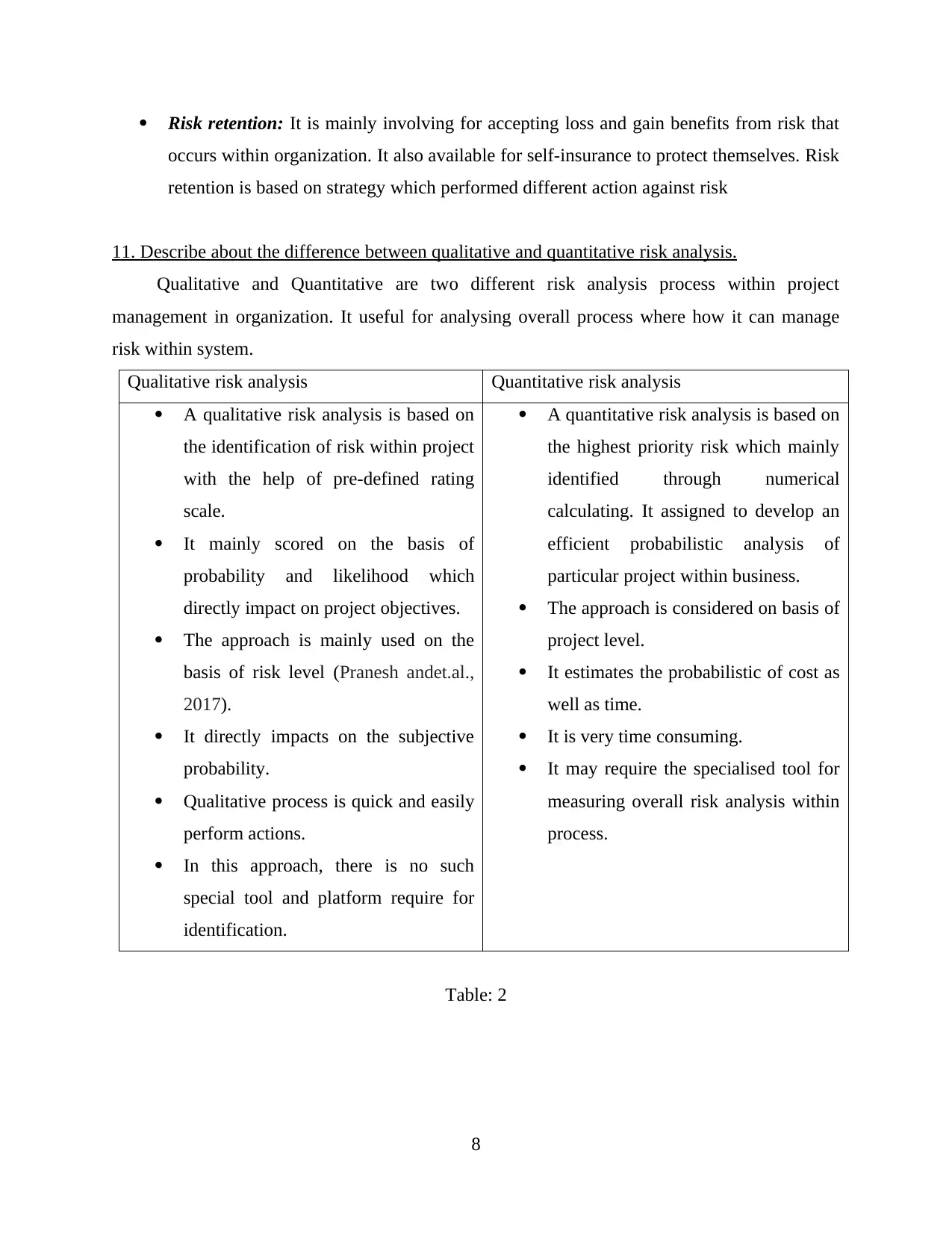
Risk retention: It is mainly involving for accepting loss and gain benefits from risk that
occurs within organization. It also available for self-insurance to protect themselves. Risk
retention is based on strategy which performed different action against risk
11. Describe about the difference between qualitative and quantitative risk analysis.
Qualitative and Quantitative are two different risk analysis process within project
management in organization. It useful for analysing overall process where how it can manage
risk within system.
Qualitative risk analysis Quantitative risk analysis
A qualitative risk analysis is based on
the identification of risk within project
with the help of pre-defined rating
scale.
It mainly scored on the basis of
probability and likelihood which
directly impact on project objectives.
The approach is mainly used on the
basis of risk level (Pranesh andet.al.,
2017).
It directly impacts on the subjective
probability.
Qualitative process is quick and easily
perform actions.
In this approach, there is no such
special tool and platform require for
identification.
A quantitative risk analysis is based on
the highest priority risk which mainly
identified through numerical
calculating. It assigned to develop an
efficient probabilistic analysis of
particular project within business.
The approach is considered on basis of
project level.
It estimates the probabilistic of cost as
well as time.
It is very time consuming.
It may require the specialised tool for
measuring overall risk analysis within
process.
Table: 2
8
occurs within organization. It also available for self-insurance to protect themselves. Risk
retention is based on strategy which performed different action against risk
11. Describe about the difference between qualitative and quantitative risk analysis.
Qualitative and Quantitative are two different risk analysis process within project
management in organization. It useful for analysing overall process where how it can manage
risk within system.
Qualitative risk analysis Quantitative risk analysis
A qualitative risk analysis is based on
the identification of risk within project
with the help of pre-defined rating
scale.
It mainly scored on the basis of
probability and likelihood which
directly impact on project objectives.
The approach is mainly used on the
basis of risk level (Pranesh andet.al.,
2017).
It directly impacts on the subjective
probability.
Qualitative process is quick and easily
perform actions.
In this approach, there is no such
special tool and platform require for
identification.
A quantitative risk analysis is based on
the highest priority risk which mainly
identified through numerical
calculating. It assigned to develop an
efficient probabilistic analysis of
particular project within business.
The approach is considered on basis of
project level.
It estimates the probabilistic of cost as
well as time.
It is very time consuming.
It may require the specialised tool for
measuring overall risk analysis within
process.
Table: 2
8
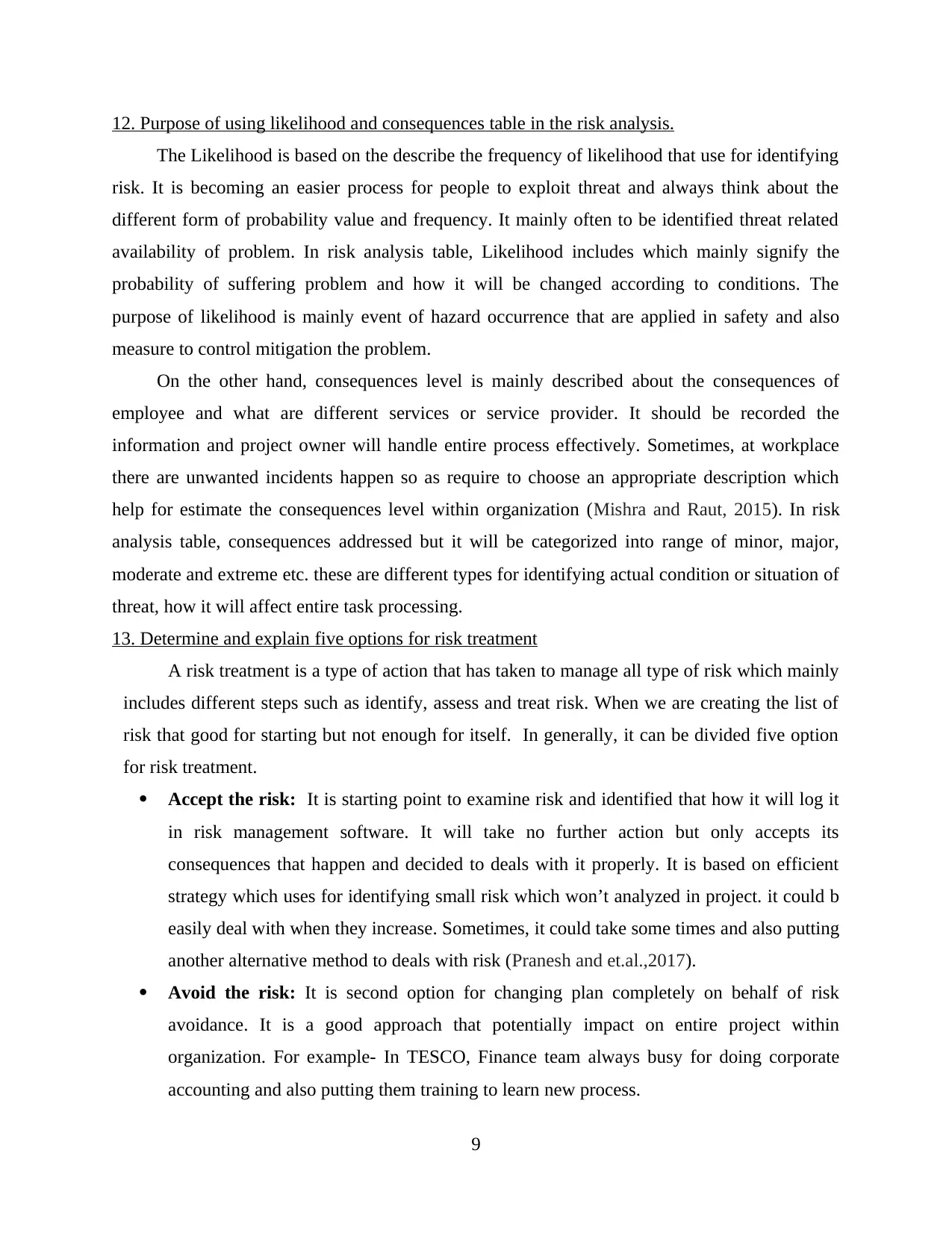
12. Purpose of using likelihood and consequences table in the risk analysis.
The Likelihood is based on the describe the frequency of likelihood that use for identifying
risk. It is becoming an easier process for people to exploit threat and always think about the
different form of probability value and frequency. It mainly often to be identified threat related
availability of problem. In risk analysis table, Likelihood includes which mainly signify the
probability of suffering problem and how it will be changed according to conditions. The
purpose of likelihood is mainly event of hazard occurrence that are applied in safety and also
measure to control mitigation the problem.
On the other hand, consequences level is mainly described about the consequences of
employee and what are different services or service provider. It should be recorded the
information and project owner will handle entire process effectively. Sometimes, at workplace
there are unwanted incidents happen so as require to choose an appropriate description which
help for estimate the consequences level within organization (Mishra and Raut, 2015). In risk
analysis table, consequences addressed but it will be categorized into range of minor, major,
moderate and extreme etc. these are different types for identifying actual condition or situation of
threat, how it will affect entire task processing.
13. Determine and explain five options for risk treatment
A risk treatment is a type of action that has taken to manage all type of risk which mainly
includes different steps such as identify, assess and treat risk. When we are creating the list of
risk that good for starting but not enough for itself. In generally, it can be divided five option
for risk treatment.
Accept the risk: It is starting point to examine risk and identified that how it will log it
in risk management software. It will take no further action but only accepts its
consequences that happen and decided to deals with it properly. It is based on efficient
strategy which uses for identifying small risk which won’t analyzed in project. it could b
easily deal with when they increase. Sometimes, it could take some times and also putting
another alternative method to deals with risk (Pranesh and et.al.,2017).
Avoid the risk: It is second option for changing plan completely on behalf of risk
avoidance. It is a good approach that potentially impact on entire project within
organization. For example- In TESCO, Finance team always busy for doing corporate
accounting and also putting them training to learn new process.
9
The Likelihood is based on the describe the frequency of likelihood that use for identifying
risk. It is becoming an easier process for people to exploit threat and always think about the
different form of probability value and frequency. It mainly often to be identified threat related
availability of problem. In risk analysis table, Likelihood includes which mainly signify the
probability of suffering problem and how it will be changed according to conditions. The
purpose of likelihood is mainly event of hazard occurrence that are applied in safety and also
measure to control mitigation the problem.
On the other hand, consequences level is mainly described about the consequences of
employee and what are different services or service provider. It should be recorded the
information and project owner will handle entire process effectively. Sometimes, at workplace
there are unwanted incidents happen so as require to choose an appropriate description which
help for estimate the consequences level within organization (Mishra and Raut, 2015). In risk
analysis table, consequences addressed but it will be categorized into range of minor, major,
moderate and extreme etc. these are different types for identifying actual condition or situation of
threat, how it will affect entire task processing.
13. Determine and explain five options for risk treatment
A risk treatment is a type of action that has taken to manage all type of risk which mainly
includes different steps such as identify, assess and treat risk. When we are creating the list of
risk that good for starting but not enough for itself. In generally, it can be divided five option
for risk treatment.
Accept the risk: It is starting point to examine risk and identified that how it will log it
in risk management software. It will take no further action but only accepts its
consequences that happen and decided to deals with it properly. It is based on efficient
strategy which uses for identifying small risk which won’t analyzed in project. it could b
easily deal with when they increase. Sometimes, it could take some times and also putting
another alternative method to deals with risk (Pranesh and et.al.,2017).
Avoid the risk: It is second option for changing plan completely on behalf of risk
avoidance. It is a good approach that potentially impact on entire project within
organization. For example- In TESCO, Finance team always busy for doing corporate
accounting and also putting them training to learn new process.
9
⊘ This is a preview!⊘
Do you want full access?
Subscribe today to unlock all pages.

Trusted by 1+ million students worldwide
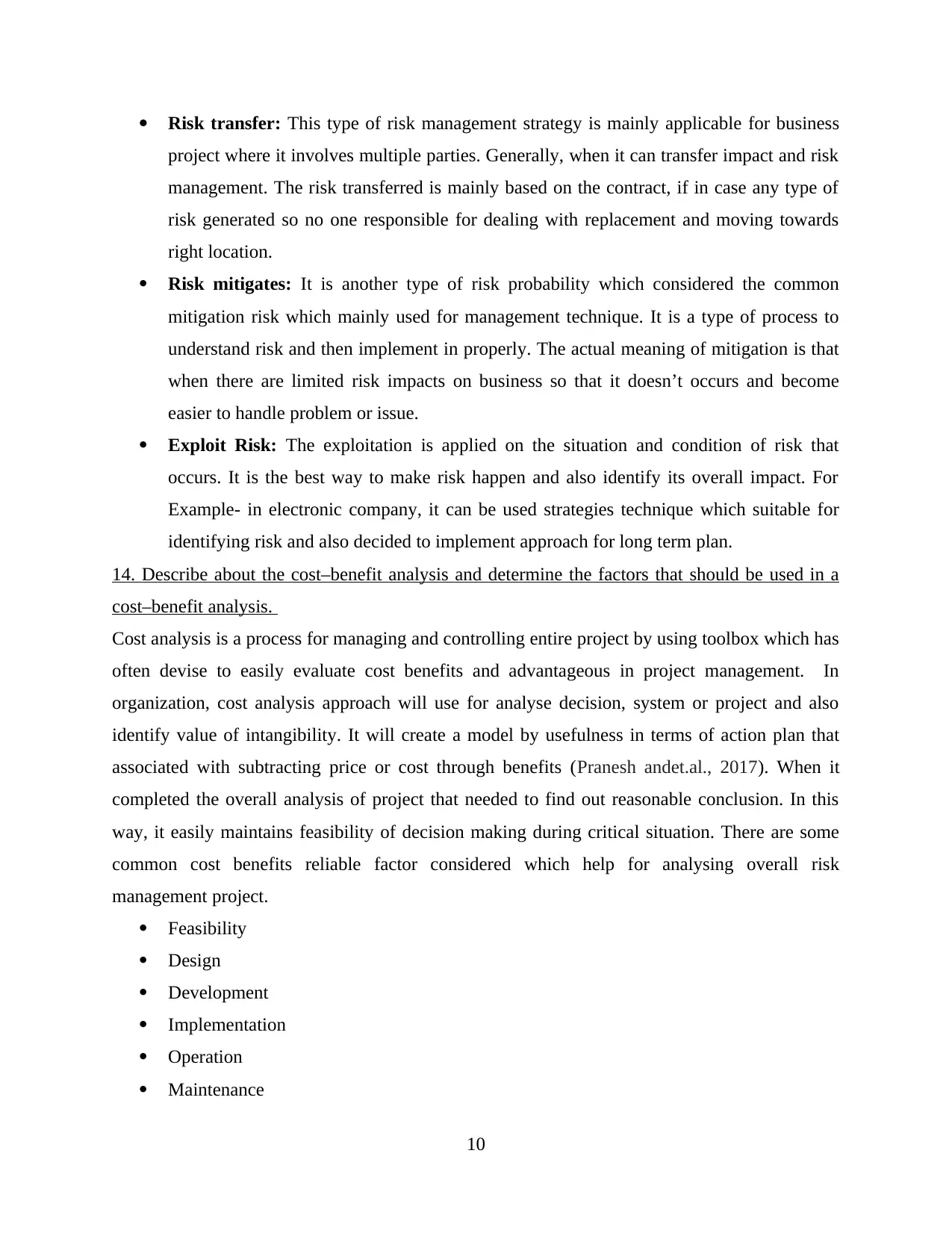
Risk transfer: This type of risk management strategy is mainly applicable for business
project where it involves multiple parties. Generally, when it can transfer impact and risk
management. The risk transferred is mainly based on the contract, if in case any type of
risk generated so no one responsible for dealing with replacement and moving towards
right location.
Risk mitigates: It is another type of risk probability which considered the common
mitigation risk which mainly used for management technique. It is a type of process to
understand risk and then implement in properly. The actual meaning of mitigation is that
when there are limited risk impacts on business so that it doesn’t occurs and become
easier to handle problem or issue.
Exploit Risk: The exploitation is applied on the situation and condition of risk that
occurs. It is the best way to make risk happen and also identify its overall impact. For
Example- in electronic company, it can be used strategies technique which suitable for
identifying risk and also decided to implement approach for long term plan.
14. Describe about the cost–benefit analysis and determine the factors that should be used in a
cost–benefit analysis.
Cost analysis is a process for managing and controlling entire project by using toolbox which has
often devise to easily evaluate cost benefits and advantageous in project management. In
organization, cost analysis approach will use for analyse decision, system or project and also
identify value of intangibility. It will create a model by usefulness in terms of action plan that
associated with subtracting price or cost through benefits (Pranesh andet.al., 2017). When it
completed the overall analysis of project that needed to find out reasonable conclusion. In this
way, it easily maintains feasibility of decision making during critical situation. There are some
common cost benefits reliable factor considered which help for analysing overall risk
management project.
Feasibility
Design
Development
Implementation
Operation
Maintenance
10
project where it involves multiple parties. Generally, when it can transfer impact and risk
management. The risk transferred is mainly based on the contract, if in case any type of
risk generated so no one responsible for dealing with replacement and moving towards
right location.
Risk mitigates: It is another type of risk probability which considered the common
mitigation risk which mainly used for management technique. It is a type of process to
understand risk and then implement in properly. The actual meaning of mitigation is that
when there are limited risk impacts on business so that it doesn’t occurs and become
easier to handle problem or issue.
Exploit Risk: The exploitation is applied on the situation and condition of risk that
occurs. It is the best way to make risk happen and also identify its overall impact. For
Example- in electronic company, it can be used strategies technique which suitable for
identifying risk and also decided to implement approach for long term plan.
14. Describe about the cost–benefit analysis and determine the factors that should be used in a
cost–benefit analysis.
Cost analysis is a process for managing and controlling entire project by using toolbox which has
often devise to easily evaluate cost benefits and advantageous in project management. In
organization, cost analysis approach will use for analyse decision, system or project and also
identify value of intangibility. It will create a model by usefulness in terms of action plan that
associated with subtracting price or cost through benefits (Pranesh andet.al., 2017). When it
completed the overall analysis of project that needed to find out reasonable conclusion. In this
way, it easily maintains feasibility of decision making during critical situation. There are some
common cost benefits reliable factor considered which help for analysing overall risk
management project.
Feasibility
Design
Development
Implementation
Operation
Maintenance
10
Paraphrase This Document
Need a fresh take? Get an instant paraphrase of this document with our AI Paraphraser
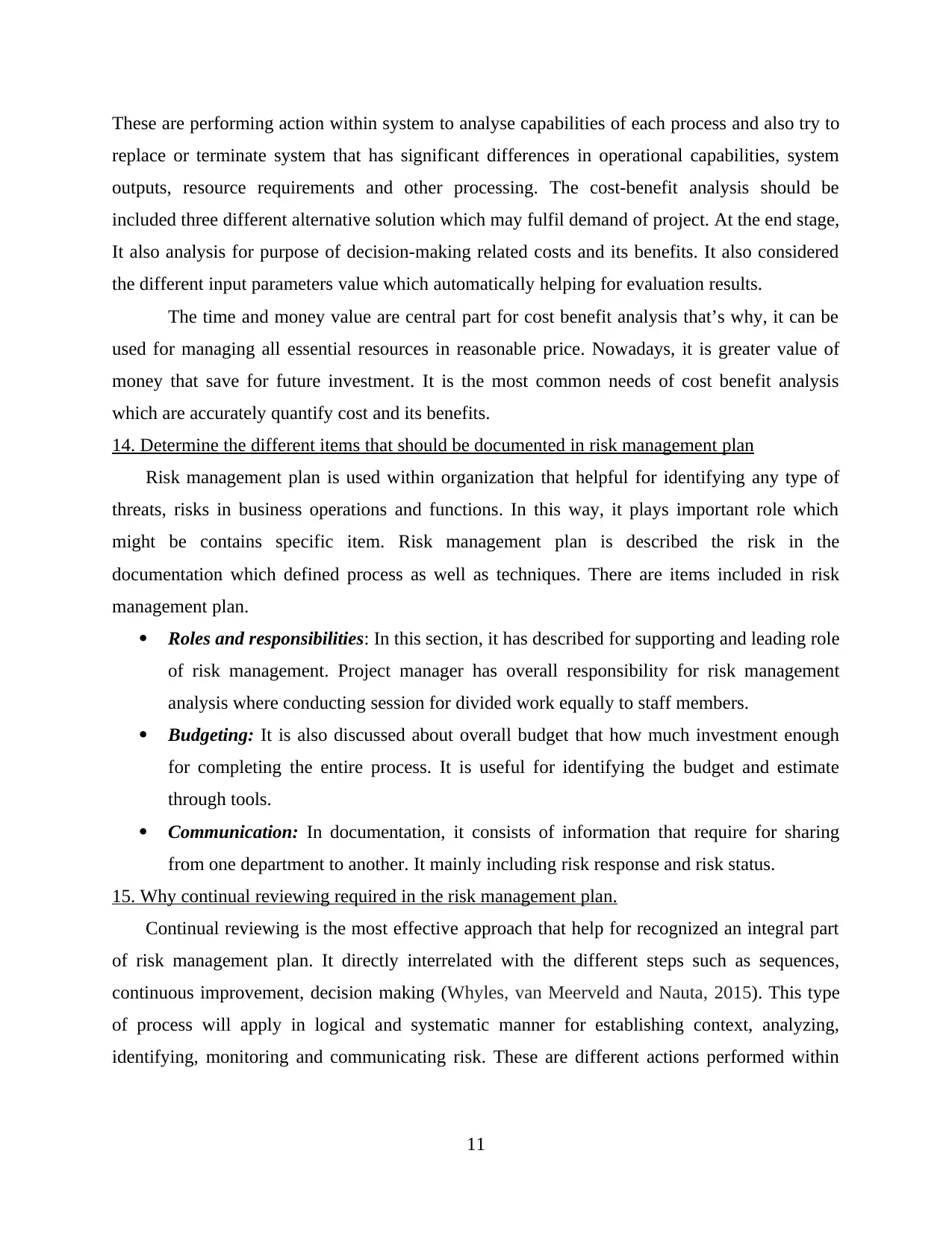
These are performing action within system to analyse capabilities of each process and also try to
replace or terminate system that has significant differences in operational capabilities, system
outputs, resource requirements and other processing. The cost-benefit analysis should be
included three different alternative solution which may fulfil demand of project. At the end stage,
It also analysis for purpose of decision-making related costs and its benefits. It also considered
the different input parameters value which automatically helping for evaluation results.
The time and money value are central part for cost benefit analysis that’s why, it can be
used for managing all essential resources in reasonable price. Nowadays, it is greater value of
money that save for future investment. It is the most common needs of cost benefit analysis
which are accurately quantify cost and its benefits.
14. Determine the different items that should be documented in risk management plan
Risk management plan is used within organization that helpful for identifying any type of
threats, risks in business operations and functions. In this way, it plays important role which
might be contains specific item. Risk management plan is described the risk in the
documentation which defined process as well as techniques. There are items included in risk
management plan.
Roles and responsibilities: In this section, it has described for supporting and leading role
of risk management. Project manager has overall responsibility for risk management
analysis where conducting session for divided work equally to staff members.
Budgeting: It is also discussed about overall budget that how much investment enough
for completing the entire process. It is useful for identifying the budget and estimate
through tools.
Communication: In documentation, it consists of information that require for sharing
from one department to another. It mainly including risk response and risk status.
15. Why continual reviewing required in the risk management plan.
Continual reviewing is the most effective approach that help for recognized an integral part
of risk management plan. It directly interrelated with the different steps such as sequences,
continuous improvement, decision making (Whyles, van Meerveld and Nauta, 2015). This type
of process will apply in logical and systematic manner for establishing context, analyzing,
identifying, monitoring and communicating risk. These are different actions performed within
11
replace or terminate system that has significant differences in operational capabilities, system
outputs, resource requirements and other processing. The cost-benefit analysis should be
included three different alternative solution which may fulfil demand of project. At the end stage,
It also analysis for purpose of decision-making related costs and its benefits. It also considered
the different input parameters value which automatically helping for evaluation results.
The time and money value are central part for cost benefit analysis that’s why, it can be
used for managing all essential resources in reasonable price. Nowadays, it is greater value of
money that save for future investment. It is the most common needs of cost benefit analysis
which are accurately quantify cost and its benefits.
14. Determine the different items that should be documented in risk management plan
Risk management plan is used within organization that helpful for identifying any type of
threats, risks in business operations and functions. In this way, it plays important role which
might be contains specific item. Risk management plan is described the risk in the
documentation which defined process as well as techniques. There are items included in risk
management plan.
Roles and responsibilities: In this section, it has described for supporting and leading role
of risk management. Project manager has overall responsibility for risk management
analysis where conducting session for divided work equally to staff members.
Budgeting: It is also discussed about overall budget that how much investment enough
for completing the entire process. It is useful for identifying the budget and estimate
through tools.
Communication: In documentation, it consists of information that require for sharing
from one department to another. It mainly including risk response and risk status.
15. Why continual reviewing required in the risk management plan.
Continual reviewing is the most effective approach that help for recognized an integral part
of risk management plan. It directly interrelated with the different steps such as sequences,
continuous improvement, decision making (Whyles, van Meerveld and Nauta, 2015). This type
of process will apply in logical and systematic manner for establishing context, analyzing,
identifying, monitoring and communicating risk. These are different actions performed within
11
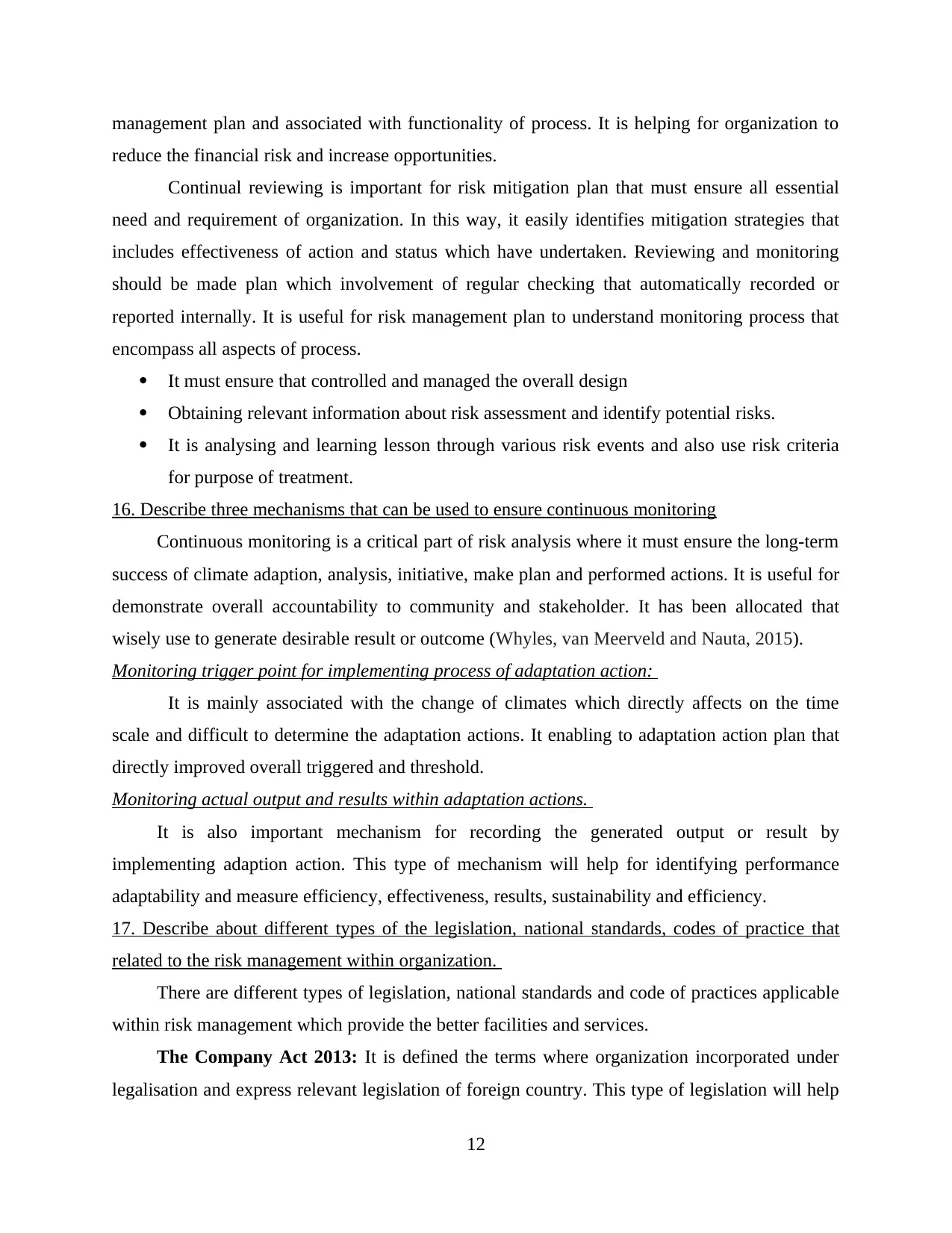
management plan and associated with functionality of process. It is helping for organization to
reduce the financial risk and increase opportunities.
Continual reviewing is important for risk mitigation plan that must ensure all essential
need and requirement of organization. In this way, it easily identifies mitigation strategies that
includes effectiveness of action and status which have undertaken. Reviewing and monitoring
should be made plan which involvement of regular checking that automatically recorded or
reported internally. It is useful for risk management plan to understand monitoring process that
encompass all aspects of process.
It must ensure that controlled and managed the overall design
Obtaining relevant information about risk assessment and identify potential risks.
It is analysing and learning lesson through various risk events and also use risk criteria
for purpose of treatment.
16. Describe three mechanisms that can be used to ensure continuous monitoring
Continuous monitoring is a critical part of risk analysis where it must ensure the long-term
success of climate adaption, analysis, initiative, make plan and performed actions. It is useful for
demonstrate overall accountability to community and stakeholder. It has been allocated that
wisely use to generate desirable result or outcome (Whyles, van Meerveld and Nauta, 2015).
Monitoring trigger point for implementing process of adaptation action:
It is mainly associated with the change of climates which directly affects on the time
scale and difficult to determine the adaptation actions. It enabling to adaptation action plan that
directly improved overall triggered and threshold.
Monitoring actual output and results within adaptation actions.
It is also important mechanism for recording the generated output or result by
implementing adaption action. This type of mechanism will help for identifying performance
adaptability and measure efficiency, effectiveness, results, sustainability and efficiency.
17. Describe about different types of the legislation, national standards, codes of practice that
related to the risk management within organization.
There are different types of legislation, national standards and code of practices applicable
within risk management which provide the better facilities and services.
The Company Act 2013: It is defined the terms where organization incorporated under
legalisation and express relevant legislation of foreign country. This type of legislation will help
12
reduce the financial risk and increase opportunities.
Continual reviewing is important for risk mitigation plan that must ensure all essential
need and requirement of organization. In this way, it easily identifies mitigation strategies that
includes effectiveness of action and status which have undertaken. Reviewing and monitoring
should be made plan which involvement of regular checking that automatically recorded or
reported internally. It is useful for risk management plan to understand monitoring process that
encompass all aspects of process.
It must ensure that controlled and managed the overall design
Obtaining relevant information about risk assessment and identify potential risks.
It is analysing and learning lesson through various risk events and also use risk criteria
for purpose of treatment.
16. Describe three mechanisms that can be used to ensure continuous monitoring
Continuous monitoring is a critical part of risk analysis where it must ensure the long-term
success of climate adaption, analysis, initiative, make plan and performed actions. It is useful for
demonstrate overall accountability to community and stakeholder. It has been allocated that
wisely use to generate desirable result or outcome (Whyles, van Meerveld and Nauta, 2015).
Monitoring trigger point for implementing process of adaptation action:
It is mainly associated with the change of climates which directly affects on the time
scale and difficult to determine the adaptation actions. It enabling to adaptation action plan that
directly improved overall triggered and threshold.
Monitoring actual output and results within adaptation actions.
It is also important mechanism for recording the generated output or result by
implementing adaption action. This type of mechanism will help for identifying performance
adaptability and measure efficiency, effectiveness, results, sustainability and efficiency.
17. Describe about different types of the legislation, national standards, codes of practice that
related to the risk management within organization.
There are different types of legislation, national standards and code of practices applicable
within risk management which provide the better facilities and services.
The Company Act 2013: It is defined the terms where organization incorporated under
legalisation and express relevant legislation of foreign country. This type of legislation will help
12
⊘ This is a preview!⊘
Do you want full access?
Subscribe today to unlock all pages.

Trusted by 1+ million students worldwide
1 out of 20
Related Documents
Your All-in-One AI-Powered Toolkit for Academic Success.
+13062052269
info@desklib.com
Available 24*7 on WhatsApp / Email
![[object Object]](/_next/static/media/star-bottom.7253800d.svg)
Unlock your academic potential
Copyright © 2020–2025 A2Z Services. All Rights Reserved. Developed and managed by ZUCOL.




